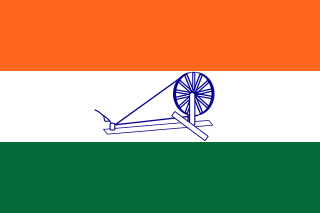
The Indian National Army was a collaborationist armed unit of Indian collaborators that fought under the command of the Japanese Empire. It was founded on 1 September 1942 in Southeast Asia during World War II.

Subhas Chandra Bose was an Indian nationalist whose defiance of British authority in India made him a hero among many Indians, but his wartime alliances with Nazi Germany and Imperial Japan left a legacy vexed by authoritarianism, anti-Semitism, and military failure. The honorific Netaji was first applied to Bose in Germany in early 1942—by the Indian soldiers of the Indische Legion and by the German and Indian officials in the Special Bureau for India in Berlin. It is now used throughout India.
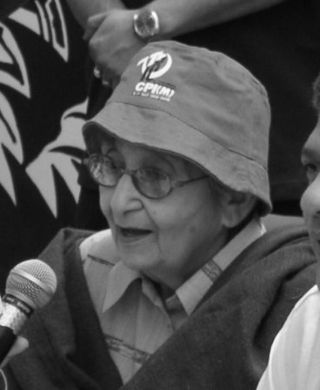
Lakshmi Sahgal was a revolutionary of the Indian independence movement, an officer of the Indian National Army, and the Minister of Women's Affairs in the Azad Hind government. Lakshmi is commonly referred to in India as Captain Lakshmi, a reference to her rank when taken prisoner in Burma during the Second World War.

The Provisional Government of Free India or, more simply, Azad Hind, was a short-lived Japanese-supported provisional government in India. It was established in Japanese occupied Singapore during World War II in October 1943 and has been considered a puppet state of Empire of Japan.
Azad Hind Radio was a radio service that was started under the leadership of Subhas Chandra Bose and Adolf Hitler in Nazi Germany in 1942 to encourage Indians to fight for the Axis powers. Though initially based in Nazi Germany, its headquarters were shifted to Japanese occupied Singapore, and later to Hyderabad, following the course of the war in Southeast Asia. After Netaji's departure to Southeast Asia, the German operations were continued by A.C.N. Nambiar, the head of the Indian Legion in Nazi Germany and later ambassador of the Arzi Hukumate Azad Hind in Germany.

Netaji Subhas Chandra Bose: The Forgotten Hero is a 2004 Indian epic biographical war film, written and directed by Shyam Benegal. The film starred an ensemble cast of Sachin Khedekar, Kulbhushan Kharbanda, Rajit Kapur, Arif Zakaria, and Divya Dutta, among others. The film depicts the life of the Indian Independence leader Subhas Chandra Bose in Nazi Germany: 1941–1943, and In Japanese-occupied Asia 1943–1945, and the events leading to the formation of Azad Hind Fauj.

Shah Nawaz Khan was an Indian politician who served as an officer in the Indian National Army (INA) during World War II. He was profoundly influenced by Subhas Chandra Bose's speeches asking POWs to join the Indian National Army and to fight for a free India, Khan led the army into North-Eastern India, seizing Kohima and Imphal which were held briefly by the INA under the authority of the Japanese. In December 1944, Shah Nawaz Khan was appointed Commander of the 1st Division at Mandalay. After the war, he was tried, convicted for treason, and sentenced to death in a public court-martial carried out by the British Indian Army. The sentence was commuted by the Commander-in-chief of the Indian Army following unrest and protests in India. After the trial, Khan declared that he would henceforth follow the path of non-violence espoused by Mahatama Gandhi and he joined the Congress party. Having successfully contested the first Lok Sabha in 1952 from Meerut, Khan had an illustrious parliamentary career. He was elected four times to the Lok Sabha from Meerut constituency in 1951, 1957, 1962 and 1971. He lost in the 1967 and 1977 Lok Sabha election from Meerut.

Lieutenant colonel Prem Kumar Sahgal was an officer of the British Indian Army. After becoming a Japanese prisoner of war, he served as an officer in the Indian National Army, which was led by Subhas Chandra Bose and had been set up by the Japanese ostensibly to fight against British rule in India.

The Indian National Army trials was the British Indian trial by court-martial of a number of officers of the Indian National Army (INA) between November 1945 and May 1946, on various charges of treason, torture, murder and abetment to murder, during the Second World War.
Ram Singh Thakuri was an Indian freedom fighter, musician and composer. He composed a number of patriotic songs including Kadam Kadam Badaye Ja and Subh Sukh Chain whilst serving in the Indian National Army.
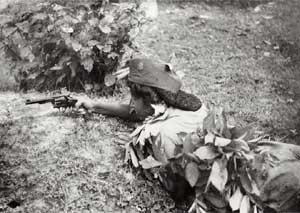
The Rani of Jhansi Regiment was the women's regiment of the Indian National Army, the armed force formed by Indian nationalists in 1942 in Southeast Asia with the aim of overthrowing the British Raj in colonial India, with Japanese assistance. It was one of the all-female combat regiments of the Second World War on all sides. Led by Captain Lakshmi Swaminathan, the unit was raised in July 1943 with volunteers from the expatriate Indian population in Southeast Asia. The unit was named the "Rani Jhansi Regiment" after Rani Lakshmi Bai, Rani of Jhansi, a renowned Indian queen and freedom fighter.

Major General Mohammed Zaman Kiani was an officer of the British Indian Army who later joined the Indian National Army (INA), led by Subhas Chandra Bose, and commanded its 1st Division.
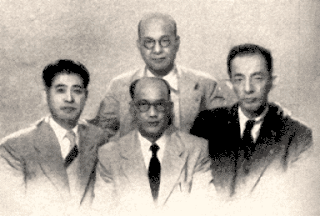
Subbier Appadurai Ayer was the Minister for Publicity and Propaganda in Subhas Chandra Bose's Azad Hind Government between 1943 and 1945, and later a key defence witness during the first of the INA trials. Ayer had travelled to Bangkok in November 1940 as a Special correspondent for Reuters before joining the Indian Independence League. In October 1943, Ayer was appointed the Minister of publicity and propaganda in the nascent Azad Hind Government.
The Nehru Brigade or 4th Guerrilla Regiment was a unit of the Indian National Army, that formed a part of the First INA and later part of the 1st Division after the INA's revival under Subhas Chandra Bose. Subhas Bose named the regiment after Pandit Jawaharlal Nehru, the 1st Prime Minister of India.
The Battles and Operations involving the Indian National Army during World War II were all fought in the South-East Asian theatre. These range from the earliest deployments of the INA's preceding units in espionage during Malayan Campaign in 1942, through the more substantial commitments during the Japanese Ha Go and U Go offensives in the Upper Burma and Manipur region, to the defensive battles during the Allied Burma campaign. The INA's brother unit in Europe, the Indische Legion did not see any substantial deployment although some were engaged in Atlantic wall duties, special operations in Persia and Afghanistan, and later a small deployment in Italy. The INA was not considered a significant military threat. However, it was deemed a significant strategic threat especially to the Indian Army, with Wavell describing it as a target of prime importance.

Subh Sukh Chain was the national anthem of the Provisional Government of Free India.
Habib ur Rahman (1913–1978) was an army officer in the Indian National Army (INA) who was charged with "waging war against His Majesty the King Emperor". He served as Subhas Chandra Bose's chief of staff in Singapore, and accompanied Bose on his alleged last fatal flight from Taipei to Tokyo, sharing the last moments of his life. Rahman also played an important role in the First Kashmir War. Convinced that Maharaja Hari Singh was out to exterminate the Muslims of Jammu and Kashmir, he joined Major General Zaman Kiani, in launching a rebellion against the Maharaja from Gujrat in Pakistani Punjab. Rehman and his volunteer force launched an attack on the Bhimber town. But, the records of the 11th Cavalry of the Pakistan Army indicate that their efforts did not succeed, and eventually the Cavalry was responsible for conquering Bhimber.
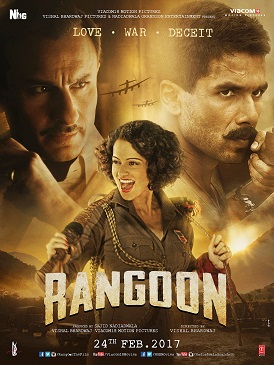
Rangoon is a 2017 Indian Hindi-language period war drama film, directed by Vishal Bhardwaj and produced by Sajid Nadiadwala and Viacom 18 Motion Pictures. The project is a period film set during World War II (1939–1945) with the leading actress supposedly playing a character based on the life and times of Mary Ann Evans aka Fearless Nadia, Bollywood's first original stunt-woman still remembered for her fiery role in the movie Hunterwali. It stars Saif Ali Khan, Shahid Kapoor and Kangana Ranaut in lead roles. The film was released on 24 February 2017 on the Mahashivratri weekend.
The INA treasure controversy relates to alleged misappropriation by men of Azad Hind of the Azad Hind fortune recovered from belongings of Subhas Chandra Bose in his last known journey. The treasure, a considerable amount of gold ornaments and gems, is said to have been recovered from Bose's belongings following the fatal plane crash in Formosa that reportedly killed him, and taken to men of Azad Hind then living in Japan. The Indian government was made aware of a number of these individuals allegedly using part of the recovered treasure for personal use. However, despite repeated warnings from Indian diplomats in Tokyo, Nehru is said to have disregarded allegations that men previously associated with Azad Hind misappropriated the funds for personal benefit. Some of these are said to have travelled to Japan repeatedly with the approval of Nehru government and were later given government roles implementing Nehru's political and economic agenda. A very small portion of the alleged treasure was repatriated to India in the 1950s.

Netaji Jayanti or Netaji Subhas Chandra Bose Jayanti, officially known as Parakram Diwas or Parakram Divas, is a national event celebrated in India to mark the birthday of the prominent Indian freedom fighter Netaji Subhas Chandra Bose. It is celebrated annually on 23 January. He played a pivotal role in Indian independence movement. He was the head of Indian National Army. He was the founder-head of the Azad Hind Government.















